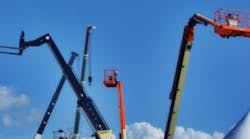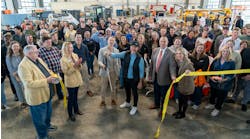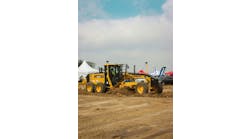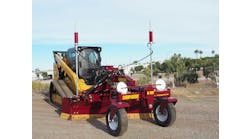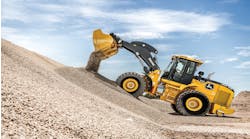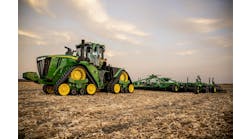The Flight of the Showcase: Lift & Access Showcase & Symposium Report
This year's Lift & Access Showcase & Symposium, hosted by Maximum Capacity Media Events and event partners Ritchie Bros. Auctioneers and RER magazine, was held in Orlando, Fla., and presented walk-arounds and demo opportunities on a wide range of equipment. Walk-arounds focused on mega boomlifts, mega telehandlers, compact rough-terrain scissorlifts, light towers and a few other items. Executives from many of the leading equipment rental companies were among the several hundred exhibitors and attendees, taking a look at many of the latest offerings, primarily from the aerial industry.
This is RER's initial report on the Showcase and space prevents us from reporting on all of the equipment at the Showcase, but we will follow up in future issues with reports on equipment presented by a number of companies, including Haulotte, JCB, Skyjack, Snorkel, Allmand Brothers, Terex, Magnum, Kohler, Wanco and Hilti.
JLG's 1500SJ — a 150-Footer That's Not Oversized
It was more than 20 years ago that JLG first introduced a 150-foot boom when it launched the 150HAX articulated boom at ConExpo in March 1991. The machine was large and heavy and required an oversize permit for on-highway transport because of its retracted width of 11-feet, 6 inches and 18-foot width with axles extended. Its width and permitting requirements made the machine not widely attractive to the rental industry.
However the 1500SJ 150-foot boom, launched 20 years later in March 2011, is only 8-feet, 2-inches wide with axles retracted, thus an oversize permit is not required. Only an overweight permit is needed, which is quicker and less costly to acquire. As a result, the machine is far more popular in rental. JLG says the 1500SJ is the industry's first 150-foot boomlift that requires only a weight permit.
“The 1500SJ has on-board diagnostics and a work envelope management system that prevents the platform from being positioned in an area that is beyond its intended area of operation,” Bill Dovey, product manager for aerial work platforms for JLG Industries told RER in explaining the machine's appeal at the recent Lift & Access Showcase.
The unit is a straight boom with a 150-foot platform height. It has 80 feet of horizontal outreach and — even at 120 feet in the air — has 70 feet of horizontal outreach. It has a 2.3-million cubic feet work envelope and a 40-percent grade-climbing ability. The machine also features a telescoping jib for greater work envelope flexibility and additional outreach at elevation. The four-section boom, extended by wire ropes in the hydraulic cylinder, a concept first pioneered by JLG in 1979, facilitates up-and-over height and reach at elevation.
The 1500SJ has 4-wheel drive, 4-wheel steer, crab steer as well as 4-wheel coordinated steer so that the front wheels are steered to the left and the rear wheels steered to the right. The machine is powered by a 74.9-hp, 4-cylinder, liquid-cooled Deutz engine.
“The platform capacity of the boom is selectable in the controls,” Dovey says. “It has either 500 pounds or 1,000-pound capacity. In the 500-pound mode you can go all the way up to 150 feet. In the 1,000-pound position you'll go up about 130 feet.”
Ground clearance is 12 inches from the axle and 25 inches from the chassis.
— Michael Roth
Aerial Work Platform Training Simulator is a Game Changer
One exhibitor at the Lift & Access Showcase that garnered a lot of attention was 3D Interactive Inc., an Edmonton, Alberta-based developer of aerial work platform simulators designed to provide a hands-on training experience using realistic operator controls.
“3DI's EWP/AWP Simulator was developed to provide a superior training experience that is both engaging and effective,” says Stuart Bagshaw, 3DI's director of construction equipment simulation training. “We use a wide variety of engagement techniques to tap the intrinsic motivation of trainees, which produces excellent retention of critical operating knowledge, skills and competencies. In addition, 3DI's Simulators provide measurable and auditable outcomes, track performance and allow trainees to practice in a safe environment without risk to themselves, co-workers, machinery or property.”
The latest 3DI training curriculum is being developed from 30 learning objectives spread across nine modules to meet the requirements of ANSI and Canadian Standards Association. Each module has a defined instructional sequence covering topics including pre-operational inspection, jobsite inspection, safe operation, major hardware components and hazard avoidance. Deliverable over the web, the 3DI training course is a convenient program that allows students to log on and complete the course at their own pace.
The 3DI training program utilizes realistic controls modeled on the controls of a popular line of AWPs that give new operators the opportunity to become proficient at operating before stepping into an actual machine. It also enables the trainer or on-site evaluator to focus on higher order skills when providing actual hands-on operation time.
“Current training programs tend to limit trainees to as little as 15 minutes of equipment operating experience,” Bagshaw explains. “In contrast, 3DI's curriculum challenges trainees through a range of tasks and scenarios that would be almost impossible and uneconomical to provide on actual equipment. Simulation-based training, whether as a stand-alone product or delivered over the web can provide trainees with adequate time to achieve proficiency in a specified task.”
Beginning an operator's training with a simulated experience gives first-time operators a chance to gain confidence with their skills before actually putting their lives and the lives of others at risk on a jobsite. Following up with real hands-on AWP equipment training solidifies the concepts learned and practiced on the simulator.
Other benefits of the 3DI simulator training are real-life sights and sounds incorporated into the program, along with the ability of the operator to see the jobsite from an actual operator's point of view. In addition, the simulator provides consistent training for each person. Because there is not a timeline to meet, there is less chance that important concepts will be skipped.
For rental companies that offer training, the 3DI simulator can address the safety concerns of renting AWPs and provide proof of training that shows the operators have met the safety compliance requirements, which reduces liability.
“Many rental companies use their sales staff to provide training sessions for clients, which can consume a good part of their day and may cause missed sales and rental revenues,” explains Bagshaw. “Rental revenues are also affected for rental companies with dedicated training departments because training sessions may be booked for weeks in advance during busy times. 3DI's simulators can provide on-demand training in a more timely and seamless manner. After the control panels have been obtained, trainees can connect via the Internet, complete the training session and be ready for a practical evaluation.”
Simulator training is not meant to replace hands-on equipment training, but it can enhance the overall training experience for new operators. “Safety concerns are substantially addressed with valid proof of training showing that the operators have met the safety compliance requirements, which reduces liability for all parties involved,” Bagshaw says.
— Brandey Smith
Platform Safety Features Are Highlights of Genie's S-125 Stick Boom
The S125 stick boom, Genie's flagship boom for more than a decade, is already well known as a reliable and durable machine that is rugged and well-liked in the rental industry. Of particular interest are some of the new developments in the platform to enhance safety for the operator.
The unit is easy to use, the controls are intuitive. Customers can purchase either a 6- or an 8-foot platform. Available are tri-entry platforms, plain gates and others. The machine has a Lincoln welding system, and a 12.5-kW generator to provide continuous power.
The newly designed safety features are of particular note. The safety features are not in response to any particular regulation or requirement, but stem from a desire on the part of Genie to protect the operator.
“Genie is very strongly of the belief that the most important thing is to make sure the operator is properly trained and that they are extremely observant of their environment and what's around them,” says Scott Krieger, senior product manager, aerial booms and telehandlers for Genie. “And to us, the first line of responsibility to ensure against injury or any problem is the operator.”
To protect the operator and people on the ground, Genie has provided what it calls secondary operator protective devices. One is the Operator Protective Structure, a mechanical cage or rollbar that customers can order on any boom model that has a 6- or 8-foot platform. The OPS is a fixed mechanical structure, tubular in design, with free space around it. The OPS can protect the operator from any sort of elevated surface that could injure the operator.
Another safety feature on the S125 is an anti-entrapment device called the Sky Siren. If the operator was to be struck from behind, for example and pushed forward into the controls, the machine would automatically stop and a siren would go off, with red lights flashing to alert anybody in the area that the operator needs immediate help. By immediately stopping the machine, the danger of the operator being further pinned by the object would be averted.
The Sky Siren is manufactured in the U.K. by Nationwide Platforms, a division of Lavendon Group, a leading aerial rental company.
A third protective device is the AFI sanctuary rail, a bar-type structure that goes on the outside edges of the operator's platform.
Another new safety feature in the platform are raised surfaces on buttons and controls so if the operator cannot take his eyes off of something outside the platform, he can feel the controls.
The S125 features a 5-foot locating jib, located 80 degrees each side and 30 degrees up and down, with great maneuverability. Serviceability on the unit is enhanced by everything being at ground level, neatly enclosed and easy to get to.
To sum it up, the Genie S-125 boom features a working height of 131 feet, 2 inches with a horizontal outreach of 80 feet and a lift capacity of 500 pounds. The out-and-up articulating jib boom option gives users an additional five feet of horizontal reach and height plus 135 degrees of working range. It comes standard with 360-degrees continuous rotation turntable that swings full circle to give operators quick and flexible positioning. The S125 has four-wheel drive, four-wheel steer capabilities and foam-filled rough-terrain tires.
— Michael Roth
Continue to Page 2
Haulotte Big Boom Saves Big Time
Haulotte Group's Tom Bell hosted a walk around of the company's HA 100 JRT articulated boomlift — part of Haulotte's series of diesel articulated big booms. Featuring a 104-foot working height and a 37-foot, 3-inch up-and-over clearance, the HA 100 JRT offers hydraulic differential lock and 15-inch ground clearance for improved rough-terrain capability.
“We are the only manufacturer of an articulated 100 on the market today,” Bell says. “One of the exciting things about this machine is we do not have an envelope system so there are no limitations to any of the movements on this machine, other than when the tower is up there's a plunger switch — you have to have the tower all the way up in order to extend the tower out.”
Powered by an 84-hp Perkins diesel engine, the HA 100 JRT has a 550-pound platform capacity. The machine's 4-wheel, independent steer is controlled by two switches, meaning each axle is independently steered allowing the operator to really maneuver into some tight spaces on a jobsite.
The HA 100 JRT offers two basket configurations — the swing gate and the drop-bar basket. At the Showcase demonstration, Bell showed how the machine is engineered so that the upper boom will come all the way down with the boom extended, bringing the basket to the ground. “We do this because we can get back to the height [we were at] faster than stowing it all the way down at lunch time,” Bell explains. “So on a jobsite where you're limited to size you can bring this machine all the way down, exit the basket during your lunch period, or if you're picking up materials, and then get back in and go straight up to height.”
The HA 100 JRT features full proportional, smooth controls and simultaneous boom functions to improve functionality. In addition, it offers an improved working area through a positive/negative articulating fly jib with 140-degree movement and 180-degree hydraulic platform rotation.
— Brandey Smith
Contractors Handle Jobsites with Care
The Working at Height symposium, held in conjunction with the Scaffold & Access Industry Association's regional meeting in Orlando, Fla., was the first of two panel discussions held at the Lift & Access Showcase & Symposium last month. Five representatives from major U.S. general contractors met to discuss the role of the general contractor in fostering the safe use of aerial work platforms, mast-climbing work platforms and scaffolding on the jobsite.
Participants included Eric Grundke, corporate safety director, Kiewit, Omaha, Neb.; Joe King from Turner Construction in Huntsville, Ala.; Jeffrey Vance, vice president corporate SH&E director at Parsons in Orlando, Fla.; Thomas Gregg, director of safety and loss prevention for Turner Construction Co. in Charlotte, N.C.; and Christian Deater, EHS director for Skanska USA in Tampa, Fla.
Representing some of the most prominent general contractor companies in North America, the panel discussed how they look at safely working at height, including the operator training they provide and incidents that have caused concern on their jobsites. Members of the panel agreed that jobsite safety begins with proper training and properly using the right fall protection equipment. That all starts with using equipment in good working order that is carefully evaluated and determined to be the best piece of equipment for the job; completing a pre-start inspection, including assessing any hazards the operator may encounter on the jobsite; and determining what steps must be taken to mitigate those hazards before any work at height begins.
Additionally, the panel agreed that the general contractor must determine if the person who is going to operate aerial equipment has the right skills and training to do so. If a subcontractor shows up on a jobsite and tells the general contractor he isn't trained on a particular piece of equipment, it is the GC's obligation to make sure they do not operate the equipment. Turner Construction's director of safety and loss prevention Thomas Gregg went so far as to ban a rental company that wasn't properly training its people.
Because GCs often employ a number of subcontractors who are moving in and out of the jobsite daily as they complete the work they are hired for, the panel stressed the importance of having daily planning meetings to outline safety expectations, discuss fall prevention plans, identify jobsite hazards and to ensure that all work at height is engineered in advance. These meetings can help workers and sub-contractors on large jobsites avoid situations where the wrong access equipment is being used to complete the job.
In a thoughtful discussion about concerns over the proper and safe use of scaffolding, the panel called for contractors and rental companies to work together to ensure that the equipment rented for a long-term job is being used safely and properly from start to finish.
“Sometimes these things are long-term rentals and the equipment is out there on the jobsite making you money, but you, as the rental company, should make contact every once in awhile to make sure that customer is using it properly,” explains Jeffrey Vance, Parsons vice president corporate SH&E director, who suggests someone from the rental company drop in on the jobsite periodically to assess that its equipment is being used safely. “Sure, you as the rental company don't have any liability, but it will save you a lot of headaches.”
Kiewit's corporate safety director Eric Grundke identified three areas his company has problems with when it comes to scaffolding. The first is the lack of guidance from OSHA for assembly, disassembly and where you tie off with scaffolding. “We need some help in finding some tie-off points that will actually work and will actually support a person,” he says.
The second area of concern Grundke identified was the need for guidance from scaffolding manufacturers for the safe way to access variable heights on a scaffold as work is being completed. The third area he addressed was the problem with contractors dropping objects off scaffolding either while working or during the assembly or disassembly procedures. Grundke called for scaffolding manufacturers to use their ingenuity to come up with a way to solve this problem to improve the work environment and the safety of those people on the ground.
Panelists agreed that whether it's working from scaffolding or operating AWPs on a jobsite, the rental company, the equipment manufacturers, the general contractor and their subcontractors must all work together to create and maintain a safe working environment and be vigilant from start to finish.
“I'm sure every company goes above and beyond what OSHA requires because we all want everyone to be safe on the job,” Vance says.
— Brandey Smith
Xtreme Roller Boom is a Smooth Operator
Xtreme Manufacturing brought its XR3034 ultra-high-capacity roller boom to the Orlando Showcase to give attendees the opportunity to see up close its roller boom design — a feature that reduces maintenance and improves boom performance.
“We went through a long period of development to build a machine that would really be robust and get a long life cycle,” said Mark Sichi, vice president of product development. “One of our most important thoughts is to get a machine to a 15- or 20-year lifecycle.”
A true pick-and-carry machine, the XR3034 has a 30,000-pound lift capacity, a 34-foot lift height and a forward reach of 17 feet, 6 inches. Instead of slide pads, the unique heavy-duty roller boom eliminates boom chatter associated with them and the need to frequently change pads. The roller boom results in a smoother boom function and extends life.
In addition, the Xtreme XR3034 features frame sway, 360-degree visibility for improved operator awareness and an innovative boom angle indicator for increased accuracy while loading and unloading materials.
“As a product development manager, what I like to do is go out and talk to customers, figure out what they're doing and if there's a better way to do it,” Sichi said. “Our building philosophy starts with the most important feature in all of our machines — rear visibility. We're always interested in gaining visibility because without visibility we have nothing. We are constantly working on improving site lines.”
Equipped with a 30,000-pound lifting hook, the XR3034 can safely hoist materials, and also offers seven attachments including pallet forks, carriages, lumber forks, utility bucket, concrete bucket, truss boom and grapples. Dual hydraulic cylinders increase precision fork leveling and the machine is equipped with a 130-hp Perkins Tier 3 engine.
— Brandey Smith
